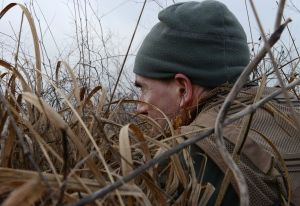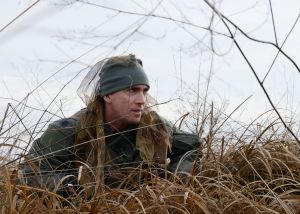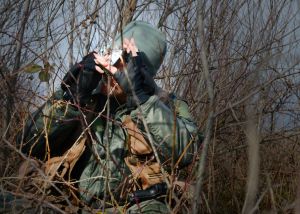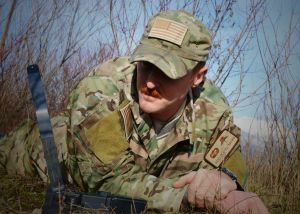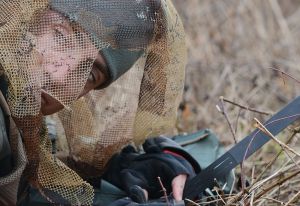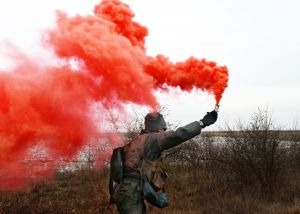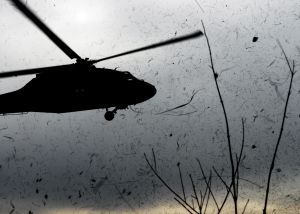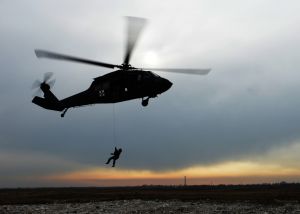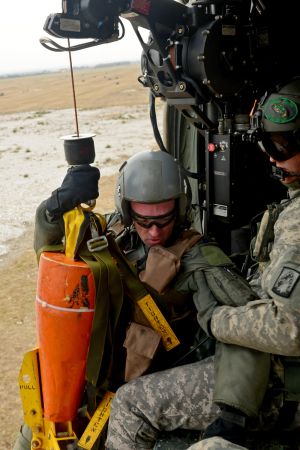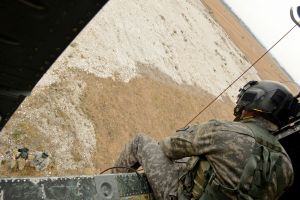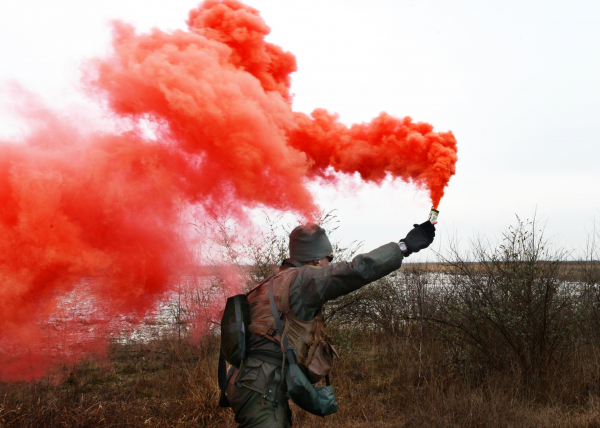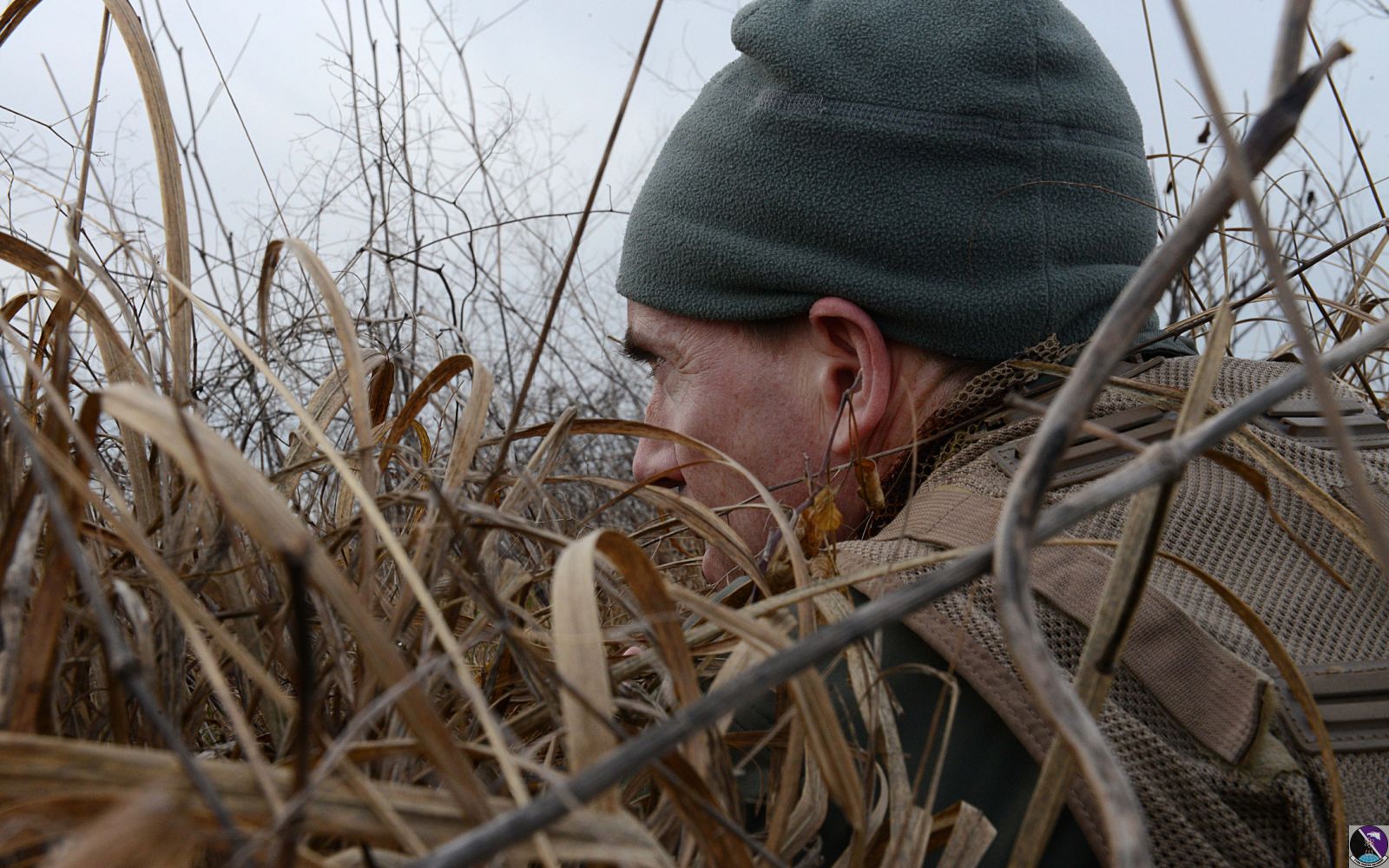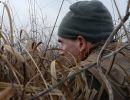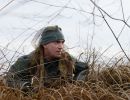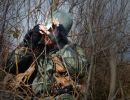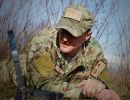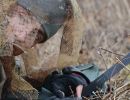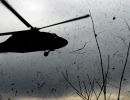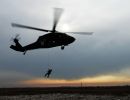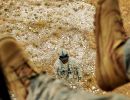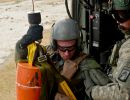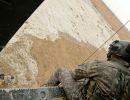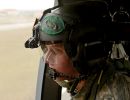Joint-service combat search and rescue training missions were held for the first-time Jan. 28 to Feb. 11 at Cellina Meduna training grounds near Maniago, Italy.
The 31st Fighter Wing teamed up with the U.S. Army 12th Combat Aviation Brigade for joint CSAR training. There were several aspects to the training mission to include close air support, Survival, Evasion, Resistance and Escape training for personnel on the ground and a search and rescue coordinated with a U.S. Army UH-60 Black Hawk helicopter crew extracting isolated pilots from "hostile" environments.
"The 12th CAB originally approached us about using our base for training and when we found out what kind of equipment they were bringing down here, which included U.S. Army UH-60 Black Hawk medical helicopters, we thought it would be the perfect opportunity to practice our personnel recovery operations," said Maj. Christopher Potter, 31st FW Plans and Programs air battle manager.
With a long-standing tradition of making Airmen the priority, CSAR training stresses the real-world threat of the Air Force's most precious commodity-- military personnel.
"Not only is the isolated person a U.S. military member but they are also someone's son, daughter, father, mother, family relative or friend," explained Staff Sgt. Claude Brown, 31st FW SERE specialist. "Obviously, the U.S. never wants to lose a military member or see them fall into the hands of the enemy and neither does their family or friend. If the training we provide can help or be the deciding factor in returning them home as safe as possible, then they will live to fight another day and go home to their friends and family."
This unique training allowed the joint personnel recovery team to exercise skills that aren't commonly applied in a field environment here. Firstly, it allowed for SERE specialists and aircrew to evade capture, communicate with assets in the air and practice hoist training with a helicopter.
"In the case of this exercise, we placed opposing forces on the ground. The individuals on the ground executing their survival training evaluated what the threats on the ground were and it really gave them an opportunity to go out there and practice their evasion skills," said Potter.
The training also provided search and rescue training for the pilots in the air. Several F-16CM Fighting Falcons were launched in support of the isolated pilot extraction and were able to practice deploying simulated ordnance on opposing forces to prevent capture. This is most commonly referred to as close air support training with pilots flying as low as 1,000 feet to the ground.
"We had the aircrews simulate what we call a semi-permissive environment," said Potter. "This is similar to what we would be operating in a deployed location, such as Afghanistan, where it is a friendly nation, but there could be some unfriendly forces there if we had to eject or if they had to get recovered."
"We attempt to create as secure of an environment as possible using our available assets so that we can safely get a recovery team in and protect our man on the ground. This is one of the top priorities during a CSAR mission," said Brown.
After successfully evading opposing forces and communicating with assets in the air, isolated Airmen needed to be extracted. This allowed for the 12th CAB to exercise their rescue procedures and hoisting training. The training also allowed for the assimilation of different rescue procedures to become more effective.
"Someone going through the survival training can do everything perfect up to actual recovery," said Brown. "But, if they aren't familiar or know how to deal with the process associated with recovery, they run a greater chance of endangering not only themselves but the recovery team. Anytime we can physically train and integrate an asset like the 12th CAB, it adds more realism to the training."
Citing history, Lt. Col. Christopher Austin, 510th Fighter Squadron commander, the more realistic a training operation is, the better chances at survival the pilot has in a real-world situation.
"I think this is excellent training--there's a will to survive," said Austin, who participated as the simulated isolated pilot. "That's the good thing about training in the field, you get to practice that will to win, will to survive. The history we have at Aviano with Capt. Scott O'Grady is a prime example of why this training is so critical."
O'Grady was a pilot assigned to the 555th Fighter Squadron here when he was shot down over Bosnia-Serb territory while patrolling a no-fly zone in 1995. He evaded capture from unfriendly forces for six days using training he received during a 17-day SERE program before he was extracted safely.
"There are many risks associated with an isolating incident regardless if they're in a combat or non-combat environment," said Brown. "The training we provide gives them the knowledge to deal with any risk they may encounter and mitigate as much of the 'what if' scenarios as possible."
AVIANO AIR BASE, Italy
by Airman 1st Class Ryan Conroy
31st Fighter Wing Public Affairs
-
U.S. Air Force Lt. Col. Christopher Austin, 510th Fighter Squadron commander, attempts to blend into the available terrain while evading opposing forces during a simulated combat search and rescue mission, Jan. 28, 2014, at Cellina Meduna training ground near Maniago, Italy. The training allowed aircrew to practice evading capture, communicating with assets in the air and an opportunity to conduct hoist training with a U.S. Army 12th Combat Air Brigade UH-60 Black Hawk helicopter crew (U.S. Air Force photo/Airman 1st Class Ryan Conroy)
-
U.S. Air Force Lt. Col. Christopher Austin, 510th Fighter Squadron commander, attempts to blend into the available terrain while evading opposing forces during a simulated combat search and rescue mission, Jan. 28, 2014, at Cellina Meduna training ground near Maniago, Italy. The training allowed aircrew to practice evading capture, communicating with assets in the air and an opportunity to conduct hoist training with a U.S. Army 12th Combat Air Brigade UH-60 Black Hawk helicopter crew. (U.S. Air Force photo/Airman 1st Class Ryan Conroy)
-
U.S. Air Force Lt. Col. Christopher Austin, 510th Fighter Squadron commander, uses a mirror to signal his location to pilots searching for him during a simulated combat search and rescue mission, Jan. 28, 2014, at Cellina Meduna training ground near Maniago, Italy. F-16 Fighting Falcons flew as low as 1,000 feet above the ground in an attempt to locate a simulated isolated pilot. (U.S. Air Force photo/Airman 1st Class Ryan Conroy)
-
.S. Air Force Staff Sgt. Claude Brown, 31st Operations Support Squadron survival, evasion, recovery and escape specialist, waits for a radio response from 31st Fighter Wing pilots during a simulated combat search and rescue mission, Jan. 28, 2014, at Cellina Meduna training ground near Maniago, Italy. The training allowed aircrew to practice evading capture, communicating with assets in the air and an opportunity to conduct hoist training with a U.S. Army 12th Combat Air Brigade UH-60 Black Hawk helicopter crew. (U.S. Air Force photo/Airman 1st Class Ryan Conroy)
-
U.S. Air Force Lt. Col. Christopher Austin, 510th Fighter Squadron commander, attempts to communicate with F-16 Fighting Falcon pilots searching for his location during a simulated combat search and rescue mission, Jan. 28, 2014, at Cellina Meduna training ground near Maniago, Italy. The joint-service training with a U.S. Army 12th Combat Air Brigade UH-60 Black Hawk helicopter crew allowed for the assimilation of different rescue procedures to become more effective. (U.S. Air Force photo/Airman 1st Class Ryan Conroy)
-
U.S. Air Force Lt. Col. Christopher Austin, 510th Fighter Squadron commander, utilizes red distress smoke to signal his location to a U.S. Army 12th Combat Aviation Brigade UH-60 Black Hawk helicopter during a simulated combat search and rescue, Jan. 28, 2014, at Cellina Meduna training grounds near Maniago, Italy. There were several aspects to the training mission to include close air support, Survival, Evasion, Resistance and Escape training for personnel on the ground and a search and rescue coordinated with a helicopter crew extracting isolated pilots from “hostile” environments. (U.S. Air Force/Airman 1st Class Ryan Conroy)
-
A 12th Combat Aviation Brigade UH-60 Black Hawk helicopter sends debris flying during its decent on a simulated combat search and rescue mission, Jan. 28, 2014, at Cellina Meduna training grounds near Maniago, Italy. There were several aspects to the training mission to include close air support, Survival, Evasion, Resistance and Escape training for personnel on the ground and a search and rescue coordinated with a U.S. Army UH-60 Black Hawk helicopter crew extracting isolated pilots from “hostile” environments. (U.S. Air Force photo/Airman 1st Class Ryan Conroy)
-
U.S. Army Sgt. 1st Class Clerow Washington, 12th Combat Aviation Brigade crew chief medic, rappels from a UH-60 Black Hawk helicopter during a simulated combat search and rescue mission, Jan. 28, 2014, at Cellina Meduna training grounds near Maniago, Italy. The training allowed aircrew to practice evading capture, communicating with assets in the air and an opportunity to conduct hoist training with a UH-60 Black Hawk helicopter crew. (U.S. Air Force photo/Airman 1st Class Ryan Conroy)
-
U.S. Army Sgt. 1st Class Clerow Washington, 12th Combat Aviation Brigade crew chief medic, waits to be lifted into a UH-60 Black Hawk helicopter during a joint-service combat search and rescue training mission, Jan. 28, 2014, at Cellina Meduna, Italy. There were several aspects to the training mission to include close air support, Survival, Evasion, Resistance and Escape training for personnel on the ground and a search and rescue coordinated with a U.S. Army UH-60 Black Hawk helicopter crew extracting isolated pilots from “hostile” environments. (U.S. Air Force/Senior Airman Briana Jones)
-
(From Left)U.S. Air Force Lt. Col. Christopher Austin, 510th Fighter Squadron commander, is pulled onto a UH-60 Black Hawk helicopter by U.S. Army Sgt. Keith Dishman, 12th Combat Aviation Brigade crew chief during a joint-service combat search and rescue training mission, Jan. 28, 2014 at Cellina Meduna, Italy. After successfully evading opposing forces and communicating with assets in the air, isolated Airmen were extracted from “hostile” areas by the 12th CAB. (U.S. Air Force photo/Senior Airman Briana Jones)
-
U.S. Army Sgt. Keith Dishman, 12th Combat Aviation Brigade crew chief, prepares to pick up U.S. Army Sgt. 1st Class Clerow Washington 12th CAB medic and U.S. Air Force Staff Sgt. Claude Brown, 31st Operations Support Squadron Survival, Evasion, Resistance and Escape specialist, during a joint-service combat search and rescue training mission, Jan. 28, 2014, at Cellina Meduna, Italy. There were several aspects to the training mission to include close air support, Survival, Evasion, Resistance and Escape training for personnel on the ground and a search and rescue coordinated with a U.S. Army UH-60 Black Hawk helicopter crew extracting isolated pilots from “hostile” environments. (U.S. Air Force photo/Senior Airman Briana Jones)
-
U.S. Army Sgt. Keith Dishman, 12th Combat Aviation Brigade crew chief, looks out the window of a UH-60 Black Hawk helicopter during a joint-service combat search and rescue training mission, Jan. 28, 2014, at Cellina Meduna, Italy. There were several aspects to the training mission to include close air support, Survival, Evasion, Resistance and Escape training for personnel on the ground and a search and rescue coordinated with a U.S. Army UH-60 Black Hawk helicopter crew extracting isolated pilots from “hostile” environments. (U.S. Air Force/Senior Airman Briana Jones)
